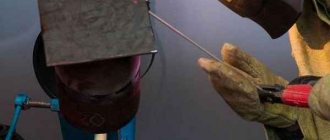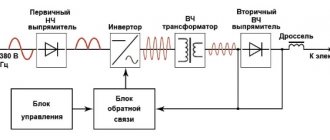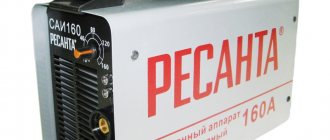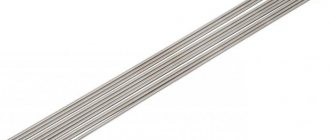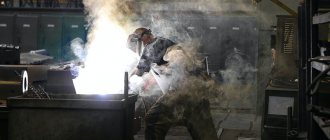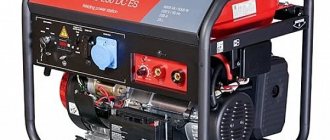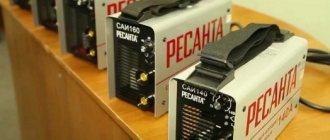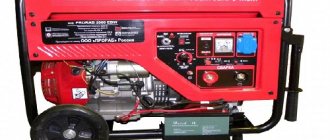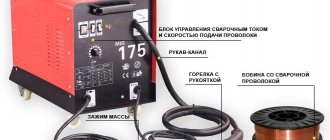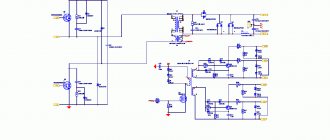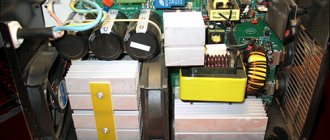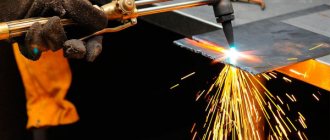Will the generator power the welding machine or not, that is the question.
Sometimes you have to weld in the absence of electricity and nothing can be done about it. Accordingly, there is a need to choose a generator for welding, which is not so easy to do.
First of all, this is a high cost, since special generators for welding are more expensive. However, even if we do not look at this factor, a number of difficult questions still arise.
For example, will a generator be able to power a welding machine? How to correctly calculate the power of a generator for welding? Which brand of generator is best to choose? These are the most pressing questions concerning this moment.
Is it possible to connect inverter welding to a Scat generator set?
You have a question!
Is it possible to connect an inverter welding machine to the generator? Theoretically, why not? If you look in more detail when calculating the load, you should take into account several important points. The inverter welding machine in its design has many capacitors, coils and electronic circuits and for the generator set is a reactive consumer with a real power factor (COS φ) of 0.7. Apparent power is calculated as the active power declared by the manufacturer and indicated in the technical specification, divided by the power factor (COS φ).
For example, let’s select generators for Arco inverter welding machines (link to the page with welding machines) with a maximum welding current of 160A, 180A, 200A.
| Welding machine power | Suitable Generator Model |
| No more than 160 amps | UGB-6000 Basic, UGB-6000, UGB-6000 E, UGB-6000E AUTO, UGB-6000 ET/6 kW |
| No more than 180 amps | UGB-7500, UGB-7500 Basic UGB-7500E, UGB-7500E AUTO |
| No more than 200 amperes | UGD-11500E |
160 A is the welding current, which is only sufficient to work with an electrode with a maximum diameter of 4.0 mm. The maximum active power consumption of such a device is 3.8 kW. Accordingly, the total power of the generating set, taking into account the coefficient of 0.7, will be 5.0-5.5 kW. Considering the recommended stock
20%, the power of the generating set must be at least 6 kW.
180 A – the device will allow you to carry out welding work with an electrode with a diameter of up to 5 mm.
The maximum active power consumption is 4.8 kW. When calculating the total power, we get 7.5 kW. The power of the generating set when connecting such an inverter, taking into account the 20% reserve, should be no less than 8.0-8.5 kW.
200 A - a serious device, powered by a three-phase network and will allow you to cook with an electrode with a diameter of up to 6 mm. The power consumption, taking into account the coefficient, will be 11.5 kW of three-phase current. The generator set for connecting a welding machine with such a current must be three-phase and with a power of at least 15 kW.
What if you buy a 250A welding inverter, but don’t use it at full power? Is it possible in this case to connect it to a generator of lower power? Advice: don't take risks. Only an electromechanical specialist will be able to determine at what welding current and how many watts the machine consumes.
The options for inverter welding machines should be taken into account. Functions such as “anti-stick” and “hot start” will require at least a little additional power for a short time.
Based on the above, we can conclude:
In order to preserve the life of the SKAT ® generator and simply not harm it, take a more serious approach to your choice. Carefully select the energy source for the device. Check all technical parameters, paying attention to indicators such as maximum power consumption and power factor. Be sure to leave a 20% power reserve for the generator.
Without any particular concerns, you can connect a welding machine with a current of 140-160 A to SKAT ® gasoline generators: UGB-6000, UGB-6000 Basic, UGB-6000E, UGB-6000T Basic, UGB-6000ET/ 6 kW, UGB-6000E/AUTO , UGB-7000, UGB-7000 Basic, UGB-7000E, UGB-7000E/AUTO, UGB-7500E, UGB-8500E, UGB-8500ET, UGB-11500E, UGB-10000ET ,
for diesel generators SKAT ® UGD-6000E, UGD-6000ET, UGD-6000EK, UGD-10000E, UGD-10000ET
Is it possible to connect welding transformers to generators?
There are three types of welders: transformers, semi-automatic machines and inverters.
You cannot connect a transformer to a brush generator - it will not withstand the load. A welder is a very powerful inductive consumer. A 130 A transformer (3 mm electrode) consumes about 7 kW at nominal value, and twice as much when igniting the arc. There is a high risk of burning the generator winding and being left without a generator and warranty repairs.
Inverter welding machines with a power of 160–200 A when welding with an electrode of 3–4 mm at a welding current of 120 amperes can be connected to gasoline generators UGB-5000, UGB-6000 or diesel generators UGD-6000E or UGD-6000EK.
Source
Is it possible to connect a welding machine to a gas generator?
Reading time: ≈5 minutes
So, you have purchased your first inverter welding machine. You will probably find an instruction manual included with it. Having carefully studied it, you will find that only a few general phrases are said about the correct inclusion. Is it really that simple? Plug the plug into the outlet and that's it? Alas, no.
An inverter-type welding machine is a complex device with its own nuances and features. By thoughtlessly plugging it into a household outlet, you risk losing the device itself or the wiring in the house. So how to connect a welding inverter correctly?
In this article we will briefly describe how to connect a welding machine to a 220 Volt home network and what should be taken into account.
Pre-check
Before you learn how to properly wire a welder, you need to make sure that the wiring in your home can handle the welding job.
Inspect the sockets, how old are they? If the outlets have not been replaced for more than 25 years, most likely all the wiring in the house is also old. This is not critical if it can withstand high current values. But often old wiring brings nothing but problems.
You are unlikely to be able to use modern welding wires with the machine if the power supply in the house is far from ideal.
You don't need to be an electrician to understand what will happen if you connect a powerful modern welder to old sockets. At best, you will be left without electricity. In the worst case, all your neighbors will be left without electricity, and your electrical appliances will simply fail.
In a word, check first whether your wiring can withstand the load. If you find that it can't, don't despair. This problem can be solved. We'll talk about this later. In the meantime, below is a diagram of connecting the welding machine.
Application of a current generator
So, you checked your wiring and it turned out that connecting a 220V welding machine is simply impossible. What to do in this situation? You can use a third-party current generator.
And at this moment, many immediately begin to remember that they keep an old gasoline generator in their dacha, which more than once saved them from sudden power outages. On the surface, the use of such generators seems like a pretty good idea, but in practice everything is different. Often, all gasoline generators are low-power and are not capable of providing a voltage of more than 5 kW for a long time.
As you understand, connecting a welding inverter to a low-power gas generator is simply pointless. To find out how much power you need, simply multiply the amperage you'll be cooking with by the voltage.
Let's take the most popular situation: you are welding with a 3 mm electrode with a current of 120 Amps and a voltage of about 40V. We multiply 120 by 40, we get 4.8 kW. This is the minimum power that a gas generator must provide. But in the calculations we did not take into account the efficiency of the welding machine, which is less than 100%. To ensure uninterrupted operation of the inverter you need at least 6 kW.
In general, a gas generator is a choice for those who no longer have any opportunity to obtain an additional power source. Ideally, before purchasing an inverter, you should check all the wiring and, if it is unsuitable, buy a welder with a built-in generator. Yes, these models are expensive and very bulky. But this is the most convenient solution to the problem.
If this solution is inconvenient for you, then you can buy a special current stabilizer for the welding machine. It connects directly to the welding inverter. This solution is suitable for a more or less stable power grid.
Use of extension cords
The topic of extension cords does not relate to connecting a welding machine, but these two issues are related. The fact is that if you select the wrong extension cables, the voltage may drop and the efficiency of the welding machine may decrease.
Why are extension cords needed? After all, the kit already contains quite long wires, usually up to 2.5 meters. At first this may be enough, but over time you will want more freedom for your actions. Especially if the device is heavy, and you need to move around the entire summer cottage or cook at height.
Therefore, we decided at the same time to tell you about connecting extension cables. First of all, remember that they cannot be used thoughtlessly. You need to accurately calculate what cross-section the extension wire should have. The maximum power that the wire can withstand will depend on this.
Let's give a simple example, using the same numbers from the previous example. Let's say we need a welding current of 120A. Wire cross-section 2.5 sq. mm. gives us 16A.
Accordingly, for welding with a current of 120A, we need a wire with a cross-section of at least 12 sq. mm. We recommend choosing extension wires with a spare cross-section. Also remember to untangle them before welding so that it cools better.
And don't forget about grounding. This is the simplest safety rule.
Also, do not buy several short extension cords and connect them together. It’s better to decide in advance on the required length and buy one wire. This way you will reduce the likelihood of a decrease in the efficiency of the welding machine. In addition, the contact connections of the extension cord will last you much longer.
Instead of a conclusion
Connecting the inverter to the grid is a simple process. You just need to learn everything once and then follow the rules. In addition, these rules also apply when you need to connect a 380V welding machine. If you have a transformer or semi-automatic in your arsenal, the algorithm of actions will not change either. We wish you good luck in your work!
[Total: 0 Average: 0/5]
Selecting a high-quality gas generator for welding | Generators for everyone
Gasoline generators (gasoline power plants) are miniature autonomous installations for energy production, which are used as a backup or main source of supply. Gasoline generators are divided into several types according to power and direction of use. Below in the article we will figure out how to choose a generator for welding without resorting to specialists.
- Types and their features
- Design and principle of operation of the unit
- Model selection considerations
- Popular brands
- Operation and care
Types and features of generators
Generators running on gasoline are mainly used as a backup source to supply electricity to any objects or, if necessary, to carry out field work with power tools that cannot be connected.
Gasoline generator for welding inverter
Every welding inverter requires electrical power. But sometimes situations arise when the work area is located far from fixed networks. However, there are no hopeless situations, and one of the ways to solve the problem is a portable generator. It is the most optimal device that provides autonomy to any electrical equipment. However, a gas generator for a welding inverter is not suitable for everyone, since there are certain requirements and technical conditions. The parameters of each unit must correspond to each other; only in this case is their productive collaboration possible.
What power generator is needed for welding with an inverter?
Reading time: 7 minutes There is nothing impossible for inverter welding in everyday life and in the garage. Need your gate repaired? Weld the gate? Build a greenhouse? Weld reinforcement when building a house? No problem. The inverter will cope with all tasks. It is compact and easy to use, it can be used by both a beginner and an old-school master accustomed to bulky transformer devices.
Naturally, any inverter needs power. To do this, just plug the device into a power outlet using a network cable. Nothing complicated. But what to do if the electricity in your area is turned off or there is no electricity at all? In such situations, you need a generator for the welding inverter. We have previously told you about what a welding generator is and how it differs from a regular generator. Today we will tell you what kind of generator is needed for a welding inverter or how to choose a generator for a welding machine so as not to make a mistake.
How can you understand what current strength is in a particular inverter?
If you need to know this indicator absolutely precisely, then it will be useful to get a current clamp with a Hall sensor, then you can check the current output by the welding machine right at the time of purchase by turning on the inverter, setting its regulator to the maximum value and measuring the current that the tool can generate.
Moreover, measuring the current alone is not enough, because the device can produce a current of 200 or 250 Amperes, but this current can hardly be called operational. Here you will need to measure the welding voltage, and if, with a rated current of 200 Amps, the voltage is lower than required, then 200 Amps in the welding inverter cannot be called working.
It is worth understanding that the operating welding voltage for different current strengths will be different, but calculating what is required will not be difficult. To do this you need to apply the following formula:
Operating welding voltage=20+0.04*device current
It is so easy to calculate that for a 160 Ampere device the voltage should be 26.4 Volts; for 200A - 28V, and for 250A - 30V
What kind of gas generator is needed for a welding inverter?
For professional welding work, special monoblocks are produced, or, as they are called, welding generators. As a rule, such devices are intended for work professionals. We will focus on selecting a generator for connecting welding inverters or a transformer for working at home, we will dwell on their features and how to choose a gas generator for a welding inverter, taking into account some of the nuances.
In newly purchased generators, it is necessary to take into account some circumstances:
- Workload;
- Power of an inverter;
- Whether there are protective functions on the inverter or not;
- Let's look at each in more detail.
How to choose a generator?
How to choose a generator? In fact, there is nothing complicated here. You only need to consider a few parameters: the power consumption of the generator, the maximum current of your inverter, the diameter of the electrodes you will use, and the compatibility of the generator with the device.
The first and second criteria are interconnected, we will talk about this later. But as for compatibility, here you need to pay special attention to the type of generator. There are synchronous, inverter and asynchronous generators. There are also hybrids that can work both synchronously and asynchronously.
Now many beginners will probably say that there is nothing to think about here, you need to take an inverter. And therein lies the biggest mistake. Because to power the device, you must choose either a synchronous generator or a hybrid. They have sufficient power and are designed for high starting loads.
We also recommend purchasing a gasoline generator rather than a diesel one. It is not as economical, but with relatively low power it works many times better than a diesel generator. In addition, the choice of gasoline generators is much larger.
If you are selecting a generator for professional equipment (for example, for expensive semi-automatic welding machines), then keep in mind that their operation from a generator does not always go smoothly. Some manufacturers explicitly say this in their instructions. Therefore, in any case, consult a specialist in the store.
Is it possible to connect a welding machine to a gas generator?
Welding machines are used in many areas of human activity. They help solve problems in everyday life in a country house, in small manufacturing enterprises, in auto repair shops, and in large industrial facilities.
Welding is especially in demand on construction sites, where until recently heavy transformer welding machines were used. They are large in size, such a unit must be transported by road.
Transformer welding is problematic to move around the construction site.
Welding process
Generator types
Manufacturers make generators for various purposes. The best option is to choose an inverter-type gasoline generator, especially for welding machines. Preferably from the same manufacturer as the welding machine.
A gasoline generator using inverters produces a very stable high-frequency voltage and current. This ensures high quality welding and a long service life of the welding machine.
Generators are divided into three types:
- Industrial models of gas generators are used in metal structures manufacturing plants that operate full time or around the clock. They have high welding currents, the connecting seams are very high quality. For such inverters, you need to choose a gasoline generator capable of delivering currents of 250-500 A.
Model of industrial inverter gas generator
- Professional models of medium power are used by housing and communal services workers, construction workers, and emergency services employees.
Professional inverter gas generator
- Low-power household ones, for short-term work, require generators with an output current of 130–200 A.
Depending on the tasks performed and operating conditions, it is necessary to select a generator taking into account the following factors:
- weight;
- dimensions;
- transportation methods;
- number of generator options;
- the length of the wires from the generator to the welding inverter (with a length of more than 15 m, the voltage and power begin to decrease);
- what type of generator, three or single phase output voltage;
- Of great importance in terms of safety is the option to reduce the voltage in idle mode.
Small-sized, lightweight, portable, gasoline inverter generators are in great demand among household consumers. The forum of the portal about welding equipment on the Internet reveals questions about which country and manufacturer of generators are better.
How to choose power?
How much power does a generator need for a welding machine? Let's figure it out.
First of all, the power of the generator for welding should be 20-30% greater than the power of your welding inverter. This is necessary not only for stable arc ignition, but also for proper use of generator resources. It is not recommended to use the generator at its maximum power limit. Therefore, if you buy a generator that is a little more powerful, you will be able to set a more gentle mode for welding. This way you will extend the life of the device, and the arc will burn more stable.
Let's give a simple example. If you have an inverter capable of delivering up to 180 Amperes of current, then we recommend purchasing a 6-6.5 kW generator, taking into account the power reserve. Based on this information, you can independently select the generator power for the welding inverter if it has different technical characteristics.
Generator selection
When you choose a generator on websites or in a hardware store, you need to carefully consider its parameters.
Look at the power that the device consumes, the highest possible current strength of the inverter, and the cross-section of the electrode rods with which you will work. Also note that not every generator may be compatible with your welding machine.
If the maximum current of the inverter and the power of the generator are related, then compatibility raises more questions. The generator can be inverter, synchronous and asynchronous; there are also hybrid types in which the properties of the last two are combined.
A beginner may think that an inverter generator is needed in this situation, but this is a common mistake. Either a synchronous or a hybrid option is suitable here, since they have quite high power.
It is better if your generator runs on gasoline rather than diesel fuel. This is not an economical option, but under the same conditions it will definitely work better than a diesel one.
In addition, finding the right version of a device with suitable power on gasoline is much easier, since there are more variations on the market.
Professional semi-automatic welding equipment does not always work well when powered by a generator. Manufacturers talk about this in technical data sheets and instructions for devices.
If you are not sure whether your device can run on a generator, talk to a store consultant about this.
Operating rules
When operating a gasoline generator for welding machines, you should strictly adhere to the recommendations from the user manual and advice from professional welders. After purchase, you should carry out a run-through check - approximately the first 20 hours of active use allow the parts to fit together.
It is best not to run the device at a power higher than 50% of the rated documented value at this time. If we are talking about working at heights, then it is worth requiring/selecting a device with a modified carburetor capable of operating in conditions of oxygen-enriched air.
It is also worth familiarizing yourself with the rules for the following operating procedures:
- Checking the oil level;
- Fuel selection;
- Refueling and checking fuel level;
- Starting the unit;
- The procedure for turning on the load;
- Stopping the engine, etc.
Competent action in any situation, both normal and emergency, will allow you to maintain the functionality of the installation for the entire operational period without the need for unscheduled repairs.
Gasoline generators with welding function
Gasoline generators with a welding function are multifunctional devices characterized by their ability to withstand heavy loads. The design of this device is an anchor that rotates due to an external drive.
A welding generator is also a power plant, but with a wider range of loads to bear. It is primarily used to start arc type welding. However, the above-mentioned versatility of such an installation is manifested precisely in the fact that in addition to power for welding, it can also be used to electrify ordinary household objects.
Among the professional areas of operation of such installations, the following stand out:
- Pipe welding;
- Installation of metal structures;
- Connecting autonomous objects to power supply, etc.
Portable welding generators are distinguished by their compactness, mobility, optimal weight and relative “silence” during operation. These qualities make it possible to use such installations in field conditions (welding, metal cutting).
Various models of such devices are distinguished by certain physical and technical characteristics and operational features:
- Manual or electric starting drive;
- Wide range of battery life;
- Certain fuel consumption;
- Noise level and other parameters.
Welding generators dominate over simple power plants, since their performance under load is many times higher, and they perform better under instantaneous overload conditions. In general, the functionality of these installations is more flexible compared to simple “household” analogues.
Model examples
Welding generator Eisemann S6401:
- single-phase;
- power – 5 kVA;
- constant current supply up to 220A;
- welding tool – piece electrode.
Excellent for welding in places located away from the central electrical network. It is characterized by optimal dimensions, operational reliability and unpretentiousness in terms of service. The systems of this installation are perfectly protected from possible failures, which ensures an extremely long and stable operating period even at sites with increased pollution and high labor intensity (construction sites).
Power station Eisemann S6400:
- three-phase switchable;
- welding current up to 220A;
- wire diameter up to 4mm.
Can work in two formats:
- three-phase – power up to 6.2 kVA;
- single-phase - 3.7 kVA.
The installation starter is manual. The design and mechanisms are perfectly protected from destructive factors, which implies an extremely long operating period of the station without the need for additional service.
Best Cheap Generators
To make it easier for you to choose a generator for your welding machine, we will additionally tell you about four high-quality models for your home and garage. This is not a rating, but rather a list of excellent generators that have performed well in a variety of conditions.
Huter DY6500L
The Huter DY6500L generator is an excellent helper in the household. Its power is 5 kW, which is enough to power a low-power inverter delivering up to 150 Amps. This is a synchronous generator running on gasoline fuel. For full operation, it is recommended to use gasoline of a grade not lower than AI-92. This model can also run on propane. Tank with a capacity of 22 liters.
Huter DY6500L is started using a recoil starter. There is a built-in forced cooling system, it is of the air type. The weight of the generator is about 80 kg, which is quite a lot. But two or three people can move it to the right place without any problems.
BRIMA LT 8000 B
We also recommend the LT 8000 B model from the famous German brand BRIMA for inverter welding. Its power is slightly more than that of the previous generator - 6 kW. But this is its rated power. And the maximum is 6.5 kW. However, remember that we do not recommend constantly using the generator beyond its capabilities. The LT 8000 B model is useful for those whose machine produces up to 180 Amps of welding current.
This is also a gasoline generator. Tank capacity - 25 liters. Powered by a reliable 190F engine. It is four-stroke, equipped with forced air cooling. Starting is carried out using built-in electronics. The generator can work without a break for up to 8 hours, then it needs a break to avoid overheating.
How to choose and what to pay attention to?
Pay attention to the value of the welding current. Usually specified in a specific range
The higher the indicator, the larger the diameter of the electrodes you can use.
Type of welding current. It can be constant or variable. It is better to give preference to models with direct current. They allow you to achieve smooth ignition of the electric arc and its stable combustion.
For power and output voltage. The higher the power, the more efficient the welding work. If we consider the issue of phasing, then three-phase welding generators allow you to connect a large number of single-phase and three-phase users.
Decide on the type of fuel. The stations run on gasoline or diesel. The second type of fuel is considered economical. But when choosing, the buyer should rely on personal preferences.
Explore additional options. A good indicator for the model is the presence of a protection system, autostart, and fuel efficiency at minimal loads.
Rules for using a gas generator
The lifespan of a generator largely depends on proper use. Compliance with the established rules begins at the start-up stage:
- By this time, the entire electrical load is turned off. The generator must be idling for several minutes, otherwise the power plant may be subject to significant overload.
- The oil level is at its standard level.
- Devices and equipment for welding with an inverter are allowed to be connected no earlier than after 5 minutes. During this time, the generator will warm up and function much more efficiently.
How to increase the service life of an electric generator
Use quality fuel
The power plant engine requires good fuel. As a rule, gasoline is used grade A-92 or A-95 . It is important that it is of good quality and does not stagnate in the tank. The shelf life of gasoline should not exceed 60 days . If stored for a longer period of time, the gas generator may not start at all.
Low-quality gasoline can interfere with the operation or damage the carburetor.
Do not fill the tank up to the neck because gasoline tends to expand under the influence of temperature and vibration. This can cause it to rip off the lid and spill onto the body.
Monitor the oil level
Oil is no less important factor in engine operation than fuel. Suitable oils for gasoline generators are 15W-40, 10W-40, 10W-30 and 5W-30. The choice of oil brand depends on the time of year and ambient temperature.
Choosing which generator is needed for the welding inverter
Some construction teams use ordinary household power supply devices to connect the welding machine, which is extremely incorrect and reduces its operating time. This is mainly due to the peculiarities of welding, as well as the different types of voltage that are used in both equipment. In this regard, the question arises: “What kind of generator is needed for a welding inverter?”
Design and principle of operation of a generator for inverter welding
A welding inverter requires a gas generator that will produce a voltage suitable for its operation. What is the essence of the problem?
The operation of a conventional generator involves the conversion of mechanical energy into electrical current. But the problem is that the output produces an alternating voltage, which is characterized by large wave fluctuations or power surges. As a result, the efficiency and productivity of the equipment is reduced, and its service life is shortened. There are two options for getting out of this situation:
- Use gas generators for inverter welding with a large power reserve.
- Connect the equipment to an inverter station, which supplies a more stable voltage.
Each option has its advantages, but when choosing, you should take into account both the advantages and disadvantages that each solution provides.
How much power does a generator need for inverter welding?
As already noted, one of the common options for resolving the issue of equipment incompatibility is the situation when connecting a gas generator for an inverter welding machine of higher power to compensate for possible voltage surges. But there are some pitfalls here. A competent calculation of equipment power will be required. The calculation is made as follows:
- The generator power for an inverter welding machine is selected according to the maximum power consumption. Additionally, a small margin is left, approximately 20 to 30% of the total station capacity.
- The calculation of power consumption is calculated by multiplying the maximum current requirement of the device with the expected voltage on the arc. You can find out these coefficients in the operating instructions. The resulting product must be divided by the efficiency of the installation. The total amount will be the maximum voltage.
Gasoline Welding Generator
Some models of mini-power plants with an internal combustion engine are equipped with the function of connecting an electric welding machine. But there is a more convenient solution for the welder - a gasoline welding generator. What is special about this device and how to choose it - we will discuss these issues further.
Purchasing a gas generator and a welding inverter separately is justified if you cook from time to time and not always in the field. In this case, the owner only wins :
- a welding machine not connected to a gas generator can be connected to the network if there is a centralized power supply;
- the generator is cheaper and can be used to power other consumers.
But with frequent trips to non-electrified objects for the purpose of carrying out electric welding work, such equipment is inconvenient for the following reasons :
- is bulky;
- a gasoline generator with a welding function may not correspond in small ways to a welding inverter from another manufacturer, which will negatively affect the quality of work.
It is more advisable to purchase a “two in one” - a gas generator for welding.
It differs from the usual one by the presence of a built-in inverter rectifier. Accordingly, there are all the functions that make using an inverter welding machine so convenient:
- Hot Start : facilitates ignition of the arc by automatically increasing the welding current at this moment;
- Arc Force : short-term increase in welding current in case of danger of welding the electrode to the welded products;
- Anti Stick (protection against electrode sticking): a short-term reduction in welding current if the electrode sticks to the workpiece during arc ignition.
An inverter is a circuit of two key fast-switching transistors, diodes and a control chip, which allows you to convert rectified current (a rectifier is installed in front of the inverter) into high-quality alternating current with any frequency and voltage.
Criterias of choice
For many users, it is enough to know that when operating a fuel generator it is possible to generate electrical energy. Professionals distinguish for themselves separate categories of such devices, among which gas generators for welding and their diesel analogues are in the same row. However, it is inappropriate to consider these generators as a separate type of device that generates electricity from a fuel resource.
The principle of operation of a welding gas generator is not much different from conventional household analogues used on the farm. The key essence of its action is that when started, a welding arc is ignited, through the winding of which an electric current flows, sufficient to maintain the arc burning process.
The process of generating current is quite simple. An internal combustion engine is hidden inside the generator. This mechanism involves rotation of the internal crankshaft with the transformation of mechanical energy into electrical energy.
However, the technical simplicity of the process of generating energy for welding is not all that you need to know about such equipment. When choosing a high-quality gas generator for welding, you should rely on more significant criteria.
The most important parameter of the gas generator to which the welding machine will be connected is the maximum level of power generated. It should not be confused with consumption. You should look for this value in the user manual or data sheet.
Naturally, the generated power of the generator should be selected in comparison with the consumption of the existing welding machine. If the latter value is not in the technical documentation, then consumption can be calculated by multiplying the maximum welding current with the arc voltage and dividing this value by the efficiency of the welding inverter.
Important! The output of the generator should have a power value higher than the consumption of the welding machine (by about 30%), which will allow it to work without overload.
It is also worth noting that there are more nuances in the combination “welding unit - generator” than just “buy with a reserve”, and therefore when selecting one device for another, you should have a detailed consultation with a specialist.
Read other articles from our experts:
Advantages and disadvantages of Japanese gas generators, examples of devices and selection criteria, what should you pay attention to?
What to look for when buying Vepr gas generators, what advantages the company’s devices have, as well as examples of models and customer reviews.
Varieties and power
Gasoline generators are classified depending on the power they produce:
- Generator for domestic conditions (from 0.7 to 5 kW) - a mini-power station that allows you to power household appliances, is compact and easy to transport. In general, gasoline generators are excellent for welding under conditions of high mobility and spot distribution of objects.
- A synchronous generator (from 5 to 10 kW) is a more universal source of electrical energy, which, with its power, allows you to work with both welding equipment and household appliances. It is quite possible to power one country house/plot.
- A welding generator (from 10 to 20 kW) is a full-fledged welding complex that intelligently combines a generating generator set and an inverter. As a rule, due to its size, a gasoline generator with a welding function is used permanently, but it can also be made in a portable format.
Above, the power of the gas generator has already been determined by the key criterion for its selection. Calculation of this value when selecting the desired welding machine is carried out as follows:
- We find the maximum level of current consumption by the inverter (Imax). For example, Imax = 21 A. Information can be printed on the housing or written down in technical documentation.
- The power of this installation can be calculated using Ohm's law by multiplying the voltage by the resulting Imax value. In the described case: 220 V * 23 A = 4620 W.
- In addition to the obtained value, we add 30% of the power reserve. 4620 + 1386 = 6006 W. Thus, the optimal generator power level should be at least 6 kW.
Is it possible to connect a welding machine to a gas generator - Metalworker's Handbook
Welding machines are used in many areas of human activity. They help solve problems in everyday life in a country house, in small manufacturing enterprises, in auto repair shops, and in large industrial facilities.
Welding is especially in demand on construction sites, where until recently heavy transformer welding machines were used. They are large in size, such a unit must be transported by road.
Transformer welding is problematic to move around the construction site.
Welding process
Structure of the apparatus
The design of the inverter welding machine is much lighter and more compact.
Structure of a large-sized welding transformer
Purpose of transformer welding machine elements:
- A closed magnetic circuit is a core made of sheet steel; the sheets are varnished before assembly.
- The handle rotates a vertical screw with a tape thread.
- The eye bolt secures the installed position of the handle.
- The cover protects against rain, snow, and random objects getting into the transformer structure.
- A vertical screw with a tape thread, when rotating the handle, regulates the amount of magnetic flux through the magnetic core.
- The running nut is the bottom base through which the vertical screw rotates.
- The primary winding is designed to supply voltage from a 220V or 380V power source.
- The secondary winding, when connected to the load (electrode to the welding site), ensures the passage of current from the primary winding, through the magnetic circuit to the secondary, then to the load. The system operates as a step-down transformer with 380/220V input and 60V output, while the current reaches up to 500A.
- The transformer housing has louvres for air cooling of the windings and rod.
- Special clamps are provided for connecting welding wires.
- The handle on the body makes it easy to move the heavy transformer on wheels.
The inverter apparatus consists of three main small-sized elements:
- low-power, voltage-stepping transformer;
- an electronic circuit board that converts and stabilizes the output welding current;
- control panel with elements for monitoring and adjusting current strength.
Design of an inverter welding machine
On the outside of the case and control panel are located:
- indicator LED, when the temperature reaches 90°C on radiators with transistors and inverter diodes, it begins to glow, warning of overheating of the device;
- The mains connection indicator diode indicates the presence of input voltage;
- At the bottom of the control panel there are terminals for connecting welding wires;
- the current adjustment knob allows you to smoothly change the welding current in the range from 10A to 180A;
- A shoulder strap is provided for transporting the device; its length is adjustable;
- The metal casing contains louvres for air cooling of the electronic circuit.
With the development of modern welding technologies, inverter machines are gradually replacing transformer machines. This topic is well covered by a forum on the Internet, where the advantages and disadvantages of inverter devices are discussed. They are better than transformer welding, have low weight and dimensions, are more functional, easy to operate, and can be easily carried by hand.
An example of transporting an inverter device
Operating principle of the inverter
The alternating current arriving at the input (220 V with a frequency of 50 Hz) is converted into direct current at the input rectifier. Filters, consisting of a set of electrolytic capacitors, additionally smooth out its fluctuations, making the current better and more stable.
Next, the semiconductor modulator again converts the DC voltage into AC voltage, with a higher oscillation frequency of up to 100 kHz. The secondary rectifier makes it constant again, the step-down transformer reduces the voltage to the level of 70 V. The welding current can be regulated by the control board from 10 to 160A, this is quite enough for welding metals.
Electronic board of inverter welding machine
The problem with the operation of inverter-type welding machines is unstable power sources. Questions about emerging malfunctions and how to fix them are well covered on the Internet forum, where experts give practical advice to amateurs and share their experiences with each other.
Semiconductor devices, modulator transistors and inverter rectifier diodes become very hot during operation. To reduce the temperature, they are installed on duralumin radiators. At high temperatures and surges in supply voltage, these elements may fail.
Selecting a Power Source
Which autonomous power source to choose for an inverter welding machine? When powering an inverter welding machine from an industrial network, there is no need to worry too much about the stability of the power source.
But in the field, on construction sites, it is not always possible to connect to power grids. To do this, you need to choose autonomous power supplies.
The most common and popular type is a small-sized gasoline generator.
But this raises a number of questions:
- how much power does the welding inverter consume?;
- will the gas generator power this device or not?;
- What should the generated power of the generator be for the welding machine to work reliably?
The topic of in what cases and which generator to connect to is widely discussed by a forum of specialists on the Internet. It tells you which welding equipment is best to use on construction sites.
Using an inverter with a gas generator
Power calculation
First of all, you need to familiarize yourself with the parameters of the welding machine, they are in the product passport, or you can find them on the Internet. For example, a welding machine produces a maximum current of 160A, it is necessary to calculate what maximum power the welding machine can consume. The formula used is:
P St = Is x Ud efficiency, where
- Р св – maximum power consumed by welding machines;
- Is – maximum current of the welding machine 160A;
- Ud – arc voltage during welding process 25V;
- Efficiency is the efficiency factor of the inverter device, most likely it will be 0.85.
R St = (160 x 25) 0.85 = 4.7 kW or 4700 W.
During the welding process, maximum power mode is never used constantly. Welders operate within an adjustable range of medium to maximum current, depending on the material they are dealing with.
We need to calculate the average power consumption of the welding machine over the period of welding work. The passport indicates such a parameter as PV, this is a temporary adjustment in percentage for the use of maximum power during operation. Typically, PV is 40%; to calculate the average power, you need to multiply the maximum by PV100, you get 4700 x 0.4 = 1.88 kW.
In some passports for inverter devices and generators, power is indicated not in kW (kilowatts), but in kVA (kilovolt-amperes). This difference must be taken into account. Both units measure power consumption, kW - shows active power consumption, kVA - total.
Ideally, when using heating devices as a load, all power is active, the current is converted into heat kVA = kW.
But with a different load, with inverter devices, electric motors and other consumers, only part of the power will be active, which will be used to spin up the rotor of the electric motor or heat up the electrode of the welding machine.
A reactive component appears, which is spent on heating the wire and semiconductor elements of electrical circuits. As a result, the total expended power will be greater than the active power.
To estimate the ratio of active and reactive power, taking into account the appearance of linear and nonlinear interference in a network with various loads, a power factor (PF) cos-ϕ was introduced.
Its optimal value is 1, when the load is a heating element; for KM inverter devices, approximately 0.8 is indicated in the data sheets.
To convert kVA to kW, you need to multiply kVA by cos-ϕ (KM); to convert kW to kVA, you need to multiply kWcos-ϕ (KM). In this case:
- 4700 kW 0.8 = 5875 kVA;
- 5875 kVA x 0.8 = 4700 kW.
For the average consumer, another method is easier to remember:
- 4700 kW + 20% = 5875 kVA;
- 5875 kVA – 20% =4700 kW.
Knowing the total power consumption of the welding machine, you can select a generator.
see also
Comments 79
So you need to go to the store and ask for the spark plug to check on the spot
I was walking here this week, saw men making fences and remembered the topic.
WELDING INVERTER AURORA MINIONE 1600 and Gasoline generator SPECIAL SB-6500E2 I bought the generator from Maxidom about a month and a half ago at a discount and cost 23,000 rubles with electric start. I took the Aurora in the winter for about six thousand, it also seems to be new. I have already welded the fence, I am pleased with the work of both.
Yamaha generator 7.5 kW Tesla inverter 5.6 kW at maximum speed without problems. there should be a reserve on the generator
Gasoline welding generator DDE DPW160i, I would take this one, it will weld accurately, the weight and dimensions are small. Order online with delivery, if the price doesn’t suit you, I’ll offer another option. In my garage I have a Champion 3300 generator and a Resanta 220 inverter, not even a Mon, but a regular one. I tried to cook with 3 MP3 electrodes, it cooks normally at a current on the device of 75-90 amperes. But I can’t imagine how long the generator will withstand this mode of operation.
5.5 kW pulls the welding inverter
As an option, a 6.5 kW gas generator and an inverter pulls at 5.5 kW, tested on myself
I saw a few years ago a two-in-one gas generator + welder of the Cayman brand
)))) Are you familiar with the repair and restoration authorities?
I'm not entirely sure about the organs. but, acting chief mechanic of RSU, three years...
We multiply the welding current by the arc formation voltage and divide by the efficiency of the inverter. We add a margin of 25% (if you don’t want to ruin the generator) and get the required generator power. For example, 80A*30V/0.85=2823 W +25% Fairly in the opposite direction, we multiply the generator power by the efficiency of the inverter and divide by the arc formation voltage, we get the maximum welding current. For example 3000*0.85/30=85A.
Varieties
The classification of electric generators takes into account their rated power:
- Household (0.5 - 5 kW) - small power stations that are designed to power household electrical appliances, lighting devices and tools. Such units are distinguished by their compact design and low weight, which greatly simplifies the process of transporting them.
- Synchronous (5 - 10 kW) are reliable and universal sources of electric current, which are at a power level that allows both to power household electrical appliances and to be a source of electricity for welding equipment. Such a device is capable of supplying electricity to a private house or plot.
- Welding machines (4-20 kW) are a full-fledged technical complex, which consists of a generator set and an inverter. The market offers both stationary models of electric generators for welding and mobile stations.
Calculating the power required for your welding machine is quite simple. First, you need to find on the case or in the instructions of the welding device its maximum current consumption level I max (for example, 21 Amperes), multiply this number by the voltage (220 Volts) and get 21*220=4600. To this number you need to add a power reserve of 30%, as a result, to power a welding machine with a consumption of 21 A, you will need a 6000 W (6 kW) generator.
Is it possible to connect inverter welding to a Scat generator set?
You have a question! Is it possible to connect an inverter welding machine to the generator? Theoretically, why not? If you look in more detail when calculating the load, you should take into account several important points. The inverter welding machine in its design has many capacitors, coils and electronic circuits and for the generator set it is a reactive consumer with a real power factor (COS φ)
0.7. Apparent power is calculated as the active power declared by the manufacturer and indicated in the technical specification, divided by the power factor (COS φ).
For example, let’s select generators for Arco inverter welding machines (link to the page with welding machines) with a maximum welding current of 160A, 180A, 200A.
| Welding machine power | Suitable Generator Model |
| No more than 160 amps | UGB-6000 Basic, UGB-6000, UGB-6000 E, UGB-6000E AUTO, UGB-6000 ET/6 kW |
| No more than 180 amps | UGB-7500, UGB-7500 Basic UGB-7500E, UGB-7500E AUTO |
| No more than 200 amperes | UGD-11500E |
160 A is the welding current, which is only sufficient to work with an electrode with a maximum diameter of 4.0 mm. The maximum active power consumption of such a device is 3.8 kW. Accordingly, the total power of the generating set, taking into account the coefficient of 0.7, will be 5.0-5.5 kW. Considering the recommended stock
20%, the power of the generating set must be at least 6 kW.
180 A – the device will allow you to carry out welding work with an electrode with a diameter of up to 5 mm.
The maximum active power consumption is 4.8 kW. When calculating the total power, we get 7.5 kW. The power of the generating set when connecting such an inverter, taking into account the 20% reserve, should be no less than 8.0-8.5 kW.
200 A - a serious device, powered by a three-phase network and will allow you to cook with an electrode with a diameter of up to 6 mm. The power consumption, taking into account the coefficient, will be 11.5 kW of three-phase current. The generator set for connecting a welding machine with such a current must be three-phase and with a power of at least 15 kW.
What if you buy a 250A welding inverter, but don’t use it at full power? Is it possible in this case to connect it to a generator of lower power? Advice: don't take risks. Only an electromechanical specialist will be able to determine at what welding current and how many watts the machine consumes.
The options for inverter welding machines should be taken into account. Functions such as “anti-stick” and “hot start” will require at least a little additional power for a short time.
Based on the above, we can conclude:
In order to preserve the life of the SKAT ® generator and simply not harm it, take a more serious approach to your choice. Carefully select the energy source for the device. Check all technical parameters, paying attention to indicators such as maximum power consumption and power factor. Be sure to leave a 20% power reserve for the generator.
Without any particular concerns, you can connect a welding machine with a current of 140-160 A to SKAT ® gasoline generators: UGB-6000, UGB-6000 Basic, UGB-6000E, UGB-6000T Basic, UGB-6000ET/ 6 kW, UGB-6000E/AUTO , UGB-7000, UGB-7000 Basic, UGB-7000E, UGB-7000E/AUTO, UGB-7500E, UGB-8500E, UGB-8500ET, UGB-11500E, UGB-10000ET ,
for diesel generators SKAT ® UGD-6000E, UGD-6000ET, UGD-6000EK, UGD-10000E, UGD-10000ET
Is it possible to connect welding transformers to generators?
There are three types of welders: transformers, semi-automatic machines and inverters.
You cannot connect a transformer to a brush generator - it will not withstand the load. A welder is a very powerful inductive consumer. A 130 A transformer (3 mm electrode) consumes about 7 kW at nominal value, and twice as much when igniting the arc. There is a high risk of burning the generator winding and being left without a generator and warranty repairs.
Inverter welding machines with a power of 160–200 A when welding with an electrode of 3–4 mm at a welding current of 120 amperes can be connected to gasoline generators UGB-5000, UGB-6000 or diesel generators UGD-6000E or UGD-6000EK.
Source
What is better, select welding and generator separately or buy a welding generator?
A welding generator is a structure consisting of a gas generator and a welding machine paired with it. The power plant is designed in such a way as to serve welding, so it has a longer service life. Other advantages :
- Short circuit protection installed;
- It is possible to work in areas remote from the central power supply (city outskirts, field, road);
- The design is more compact than if you connect welding separately;
- The cost is lower than a diesel generator of similar power.
- Such an electric generator can only be used for welding;
- Gasoline has better fuel consumption and is more expensive than diesel;
- Cannot be powered from the central network;
- Low motor life.
The most significant limitation is that it cannot be used as a backup power source for other consumers. It is intended for welding only .
If you select separate power for welding, it is better not to use it for other purposes, and vice versa, if you have a power station at home for backup power, try not to connect welding to it. This can result in breakdowns and costly repairs.
A welding generator is the best option if you are professionally engaged in repair work, constantly traveling to open areas without access to electricity. You don't have to connect or configure anything - just start the engine and adjust the current to the diameter of the electrode. Fewer wires and easier to manage.
But, on the other hand, this way you will not be able to connect the structure to the central network. The average gasoline consumption is 0.5-0.6 l/kWh, and this will cost 10 times more than when connecting the device to the central network. In addition, with such a consumption, electric generators have limited autonomy. On average it is only 3-5 hours.
If you carry out most of your welding work with access to a central power grid, it is cheaper and more profitable to buy a generator separately . But, no matter what design you choose, it still requires proper care and maintenance. This is the only way you can increase the service life. Better yet, ask all your questions to a good specialist (by following the link you will find a special feedback form https://axiomplus.com.ua/elektrogeneratory/).
